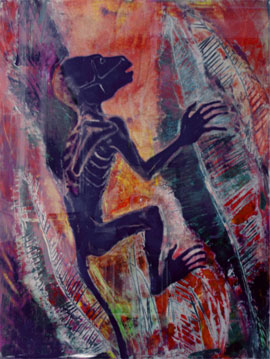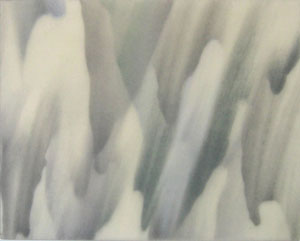Museum of Natural Histories
John Haberin New York City
Natural Histories and Shane Hope
At least since Leonardo began his notebooks, artists have claimed fidelity to an impersonal nature. And at least since William Blake, artists have claimed to free humanity from the suffocating logic of science. "Art," he wrote, "is the tree of life. Science is the tree of death." And all the while, artist materials developed as in a laboratory. A companion article explores how new and old media tempt artists to look for parallels with science, and where they fail.  However, older ideals persist, too, for both art and science.
However, older ideals persist, too, for both art and science.
One can imagine a history from medieval scholars and manuscript illuminators, through the Renaissance, to the Enlightenment—and right up to the twentieth century, when watercolors contributed to science. Did Romanticism break with that history or not? One way or other, artists are still fascinated by science and repelled by it. Maybe that explains why many are drawn to a science concerned less with mathematical laws than with new species and strange phenomena. Call it less science than a museum of natural history. Or call it natural histories, in the plural.
One show does. "Natural Histories" inaugurates a Brooklyn gallery devoted to a similarly old-fashioned pursuit, the artist's book. It suggests art and science alike as a proliferation of strange signs. So, in a way, does Shane Hope, who exploits molecular-modeling software.
A natural history of Brooklyn
Romantics often combined the roles that William Blake found at odds with one another—of ever-patient explorers and the creative imagination. Think of J. M. W. Turner, strapped to a mast to observe a storm. As it happens, scientists were doing much the same thing, give or take the melodrama. People still prize sketches by biologists and astronomers then, for both their beauty and their place in newly emerging theories. Science itself was emerging as a discipline, against a background of eighteenth-century natural history. Dorothea Rockburne still does not so much put aside abstract painting as layer over it, with the oldest natural history of all—charting the night sky.
For its opening show, Central Booking looked back to an older time and to the present. "Natural Histories" includes delicate drawings and prints between design and nature. It includes a monkey by Mary Frank, in deep blue against a deep red monoprint, bent like a fossil in mystic contemplation (although not so very far after all from the unflinching realism of Frank's latest work). It includes a closed book by Ana Mendieta, who had quite a habit of identifying herself with nature. Mostly, though, it has an eye to less-familiar artists and to Brooklyn's own natural histories. It even has Long Island City weather reports, from SP Weather Station.
Both realism and truth took a beating in the last century or so, as did art and science or art and planet earth. Science showed up again mostly as technology became new media and both threatened to reduce humanity to twisted data. For the Dumbo gallery, an older model of science and the natural history museum comes naturally. The gallery will specialize in artist books, and a second room has dozens. Just when science textbooks are adding more and more fine illustrations, these artists can still cherish books as something to hold in one's hand. No wonder they want to reclaim art and science for natural history.
Many works aspire to the scale and intimacy of a book or a Leonardo notebook, like insects (also a subject for Catherine Chalmers) by Helga Eilts and Jule Rump or Humanist Prayer Flags by Donna Maria de Creeft. Others aspire to its uniqueness, like monoprints of single species by Robin Holder, or fragility, like painting on chiffon by Desirée Alvarez. Some directly evoke dated modes of observation—like Case Studies in Taxidermy Restoration by Heidi Nelson, hand-painted stereographs by Julie A. McConnell, photographs on glass by Amina Bech, the composting of an Earth Volume by Michelle Wilson, and a textbook of engravings wrapped around pine cones by Steven Daiber. Some span a corner wall or migrate overhead, like butterflies by Sabra Booth and night creatures on shaped plywood by April Vollmer. When colors appears on canvas, by Holly Sears and Gerhard Mantz, they actually look the most like science fiction rather than science, with sharp reds out of late Romanticism. Think of Thomas Moran rather than Thomas Cole.
Sometimes, though, the work does spill into the present, like those creatures overhead. And then things get messy, like the pile of Gowanatopia on the floor by Judy Hoffman.  Apparent shards or growths in a petri dish, from Travis Childers, turn out to be Silly Putty—with faces peeled from the papers, of course. On video, Chris Jordan compresses six days of the Chinatown skyline into minutes, and how time flies. For Sara Garden Armstrong, the changes in nature remain slow and elusive. Her fluid grays represent the water's depth, like new media for Marina Zurkow and Sarah Rothberg, and wash over into abstraction.
Apparent shards or growths in a petri dish, from Travis Childers, turn out to be Silly Putty—with faces peeled from the papers, of course. On video, Chris Jordan compresses six days of the Chinatown skyline into minutes, and how time flies. For Sara Garden Armstrong, the changes in nature remain slow and elusive. Her fluid grays represent the water's depth, like new media for Marina Zurkow and Sarah Rothberg, and wash over into abstraction.
Central Booking fills a real need, when the Center for Book Arts must focus on its active workshop, and galleries like BravinLee Programs must mix books with other media—in such cases as Charles Ritchie, with a single artist. It may even have to pare back its enthusiasm, after an opening with one hundred and twenty contributors (although its next show, on the theme of anthropology, again packed both rooms to the max). It also gets to share with others a reminder of natural histories. Joseph Stashkevetch sketches flowers, birds, the water's surface, and a rock face in the demanding medium of Conté crayon. The large drawings give an air of permanence to shadow. Their flower images could all belong to a single object in slow motion.
Having a ball
Worried about understanding so many puzzling and intricate connections between biology and art—or just missing Gabriel Orozco and his whale? By now, art lovers are used to formulas and symbols they cannot decipher, from Asian calligraphy to Christian iconography, not to mention art criticism. So why not molecular models? Shane Hope uses software meant for chemical structures the way other painters use oil or acrylics. From a distance, the prints on aluminum look like busy, bright abstractions. Up close, they may or may not show signs of life.
Hope lies at the intersection of any number of issues. People have long debated the relationship between the visual arts and sign systems or mathematics and art—and not just those like Jenny Holzer, Lawrence Weiner, or R. Luke DuBois who treat text as art. Hope also points to the old dream of capturing nature. He underscores the differences between art and science, too. While digital artists often see new media as a universal language, he applies the tools of real science to the products of his imagination. The software developer says that Hope exploits every last one of its styles and conventions.
The sheer geekiness connects to another trend as well—artists like Cory Arcangel or Ryan Trecartin who treat galleries as playgrounds for boy toys. The show's title, "Your Mom Is Open Source," already suggests adolescent play. (Not that the software comes free, or "open source," but it does conform to a standard file format, and a good programmer can tweak its output.) Some less-distinguished work mimes a still earlier life stage. Notes scrawled on lined paper suggest the insights of gifted but not terribly coherent preschoolers. At a professional level, though, Hope knows what he is doing, on a scale of up to four by five feet.
No doubt drawing on a computer has lost its novelty. The all-over compositions are mostly shapeless, and the details do not mean all that much. They include the familiar colored balls, ribbons, and grids, along with some surprising intruders. In science fiction, real beings take over at the molecular level. Here the representational elements may look cuddly or robotic, but they never stop smiling. Only the sense of play, the digital puzzles, dark clouds akin to vegetable matter, and the sheer asymmetry bring at least a few closer to life.
I have tried elsewhere to pin down parallels and differences between art and science, including art and optics, after taking in Jacob van Ruisdael landscapes, while Rosemarie Trockel makes natural history into a collaboration at the heart of her retrospective. New media—from computer-driven art like Hope's to artist holograms by James Turrell—tempt artists to think of themselves as uniquely in touch with nature. They may not see themselves as a passive mirror onto nature, as before Modernism, but they can imagine art and science as sign systems encompassing nature. But the split between art and science goes back well before the twentieth century. With Romanticism, art becomes the expression of an active mind, just as John Constable humanizes nature with his studies of clouds and Salisbury Cathedral. Science could seem to threaten that view, with an impersonal nature, but science had new ambitions, too.
The problem was that science had changed quite as much as art. The naturalist was ceding to the lawmaker, discovering not just tiny mysteries, but entire realms. A key in a lightening storm for Benjamin Franklin gives way to laws uniting electricity, magnetism, and light. The discovery of new and extinct species leads to a theory of evolution. As for Hope, heat and chemistry make sense at the molecular level. Natural history becomes history, and the creative act struggles to keep up—or to remember the past.

"Natural Histories" ran at Central Booking through November 8, 2009, Joseph Stashkevetch at Von Lintel through October 10, and Shane Hope at Winkleman through August 7.




